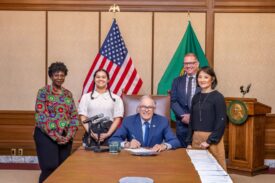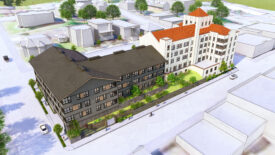The gist:
Four strategies to encourage healthier communities, based on the research from the Cascadia Scorecard.
The details:
Sprawling suburbs—where a car is necessary for virtually every trip—are taking their toll on the health of northwesterners. The extra driving and physical inactivity associated with sprawl have been linked to major health risks, such as more than 2,000 car-crash fatalities a year in the Northwest, and obesity rates that have doubled since the 1990s. Communities that have curbed sprawl tend to have lower rates of obesity and chronic illness, and residents drive less, which reduces the risk of a serious crash.
Individuals and institutions can take simple steps to create compact, complete communities that enable residents to get around without a car and encourage physical activity and connections among neighbors.
Create healthy communities.
Places that are compact enough to foster walking and biking tend to be healthier. And reducing driving diminishes car crash risk and limits exposure to pollution. To support healthier, safer communities, we can:
- Encourage a blend of stores and services within residential areas and a grid street design with direct routes between destinations to promote walking and biking.
- Allow infill development and accessory dwelling units (sometimes called “granny flats”), which can modestly increase density and help more people live in pedestrian-friendly places. Neighborhoods with a blend of housing types also help aging residents to stay in their community throughout their lives and maintain social connections.
- Ease parking requirements. Local land-use rules often require developers to provide overabundant parking, which makes commercial and infill development more expensive while spreading destinations farther apart.
Seattle’s “center city” strategy to attract downtown residents, and Oregon’s Damascus/Boring Concept Plan, which proposes channeling growth into a concentrated mix of homes and jobs in a well-designed core, are examples of policies that provide a wider range of options for residents that want to walk or take transit to most destinations.
Vancouver, BC, has successfully encouraged growth into a compact, walkable downtown. Partly as a result, trips by foot or bike in the city have increased about 30 percent in the last decade, and vehicle traffic declined by 10 percent. BC, which has the region’s two most compact cities, has a one-third lower fatality rate from car crashes and about half the obesity rate of the Northwest states.
Budget for health.
Road and transit planning budgets for land, labor, and materials, but doesn’t consider the potential health and economic impacts from increased traffic risk and physical inactivity related to sprawl. To account for the full cost of transportation infrastructure we can:

- Require transportation planners to investigate and incorporate the hidden health costs of building roads, from pollution to traffic deaths to inactivity. Car crashes may drain the Northwest states’ economies of approximately $8 billion per year. And the total costs of obesity and physical inactivity may top $11 billion per year in the region. A King County, Washington, project called LUTAQH, is developing an assessment tool to measure such health impacts, which will help planners make the best—and healthiest—transportation buys first.
- Invest in cost-effective features that promote safety and health including sidewalks, bike paths, traffic safety, interconnected streets, and transit.
Washington state recently adopted a policy to allow investments in active transportation such as bike paths and transit routes along with new roads and reconstruction projects in Central Puget Sound, giving citizens more healthy choices for their daily trips.
Reveal the real costs.
Taxpayers and utility rate payers often end up paying the infrastructure costs for new development such as roads, sewer lines, schools, fire stations and police, regardless of where they live or how much they drive. The true costs of new development and driving are often hidden through subsidies. To make the price of development tell the truth, we can:
- Require new development at the urban fringe to pay its own way, rather than being subsidized by taxpayers, which would encourage development of infill housing and compact communities, where infrastructure costs are lower.
- Pay-as-you-drive (PAYD) insurance, gaining traction in Oregon and Washington, is an example of making prices tell the truth about driving. PAYD would reward motorists for driving less by making buying car insurance more like buying gasoline: the less you drive, the less you pay.
Make healthy choices.
When making personal choices about where you live and work, take the health, time, and economic impacts of extra driving into account, and consider all the options.
- When you move, think about the layout of the community where you’d like to live. Are stores and services close by, or within a short ride or drive? Are the streets designed to be pedestrian-friendly? How do you want to spend your commute time—in a car, on foot, or on a bus?
- Be more active—walk and bike as a form of transportation. Burning just 10 extra calories per day—the amount burned during a 2- to 3- minute walk—can prevent a pound of weight gain per year, which is enough to keep many people from becoming overweight.
- Pay attention to community design issues and support policy changes that will make your neighborhood more walkable and complete. Talk to your friends and neighbors about the benefits of living in a compact community and support zoning that allows more transit, bike lanes, and a mix of housing and shops.






